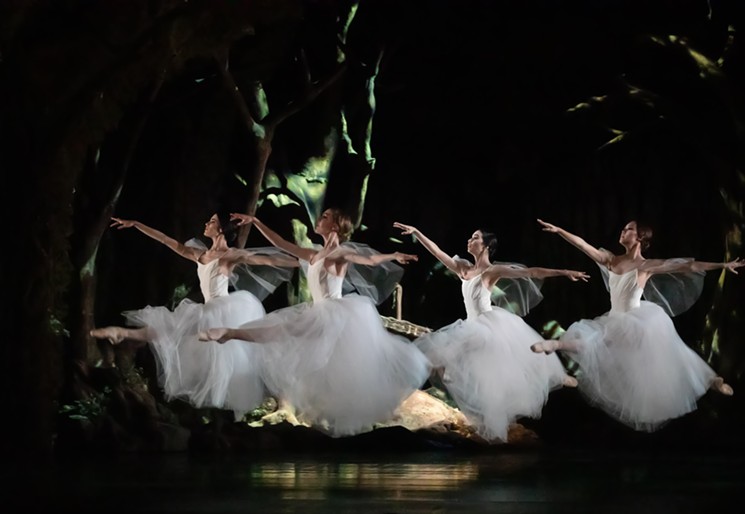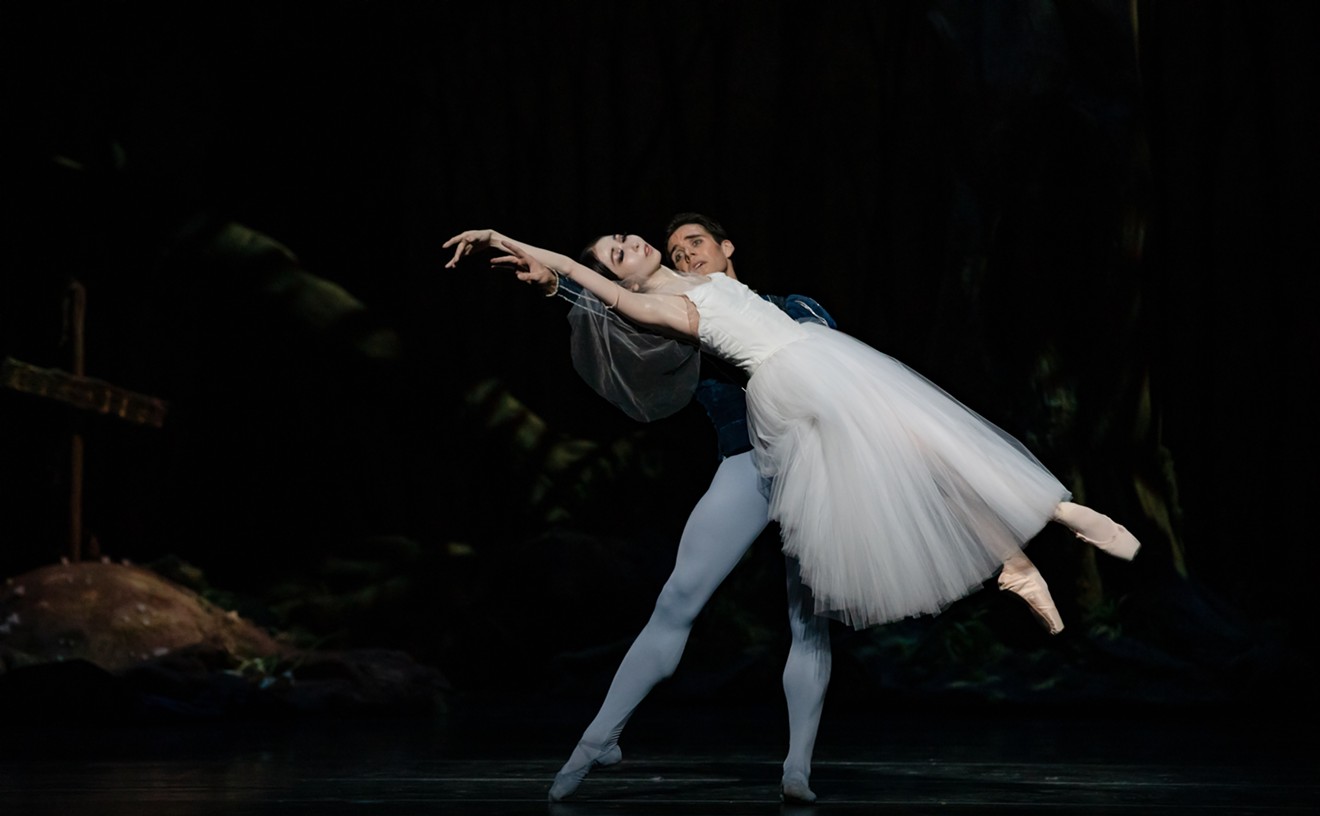You can decide whether or not the punishment fits the crime, but the Wilis, as they are known, drawn from Heinrich Heine’s De l’Allemagne, served as an inspiration for Giselle, opening Houston Ballet’s 50th anniversary season.
Giselle, the Romantic ballet credited for setting in motion Houston’s dance town trajectory, was conceived by Théophile Gautier and inspired by the night dancers found referenced in Heine’s book and Victor Hugo’s “Fantômes.” The character of Giselle is a peasant girl, tricked into falling for an engaged nobleman disguised as a fellow villager. When the jig is up, Giselle, who’s already weak heart is broken, goes mad and dies. This is where the Wilis come in, anxious to recruit Giselle as one of their own, and anxious to make Albrecht their next victim.
When Stanton Welch created his own Giselle, which premiered just three years ago in 2016, he chose to revisit Adolphe Adam’s original score, adding back sections often cut and expanding the show (and therefore, the narrative) while adding even more opportunities for dance. For a little perspective, the original 1841 choreography from Jean Coralli and Jules Perrot apparently broke down to 54 minutes of mime and 60 minutes of dance. Before we get to whether this expansion is good or bad, Giselle starts and stops first with its Giselle, and Yuriko Kajiya embodies the role created on her with ease.
Kajiya is the picture of girlish naiveté and joy in the first act, playful flicks of her feet, graceful extensions, and photo-worthy arabesques. Her love for Albrecht is palpable, her vulnerability aching as she looks at Connor Walsh’s Albrecht awed, like she can’t believe he’s real. When it’s revealed that he is too good to be true, Kajiya’s dawning horror manifests through the trembling that racks her body, the shakes of her head, her labored breathing. She descends into madness, falling to the ground, a thousand-yard stare taking over as she gets lost in her mind, in her memories. Her movement becomes jerky, almost as though pulled against her will by a mysterious force. In the first act, she is often constrained, at times by her mother, other times by her own weak constitution. But as a spirit in Act II, she emerges unrestrained and powerful, showing off her flexibility, lines, and balance.
Connor Walsh’s Albrecht is a cad, but one shown to ultimately be a good guy who does a bad thing. Though Giselle doesn’t catch on, Albrecht’s nobility can’t be masked by the costume he dons or the sword he ditches to blend in with the villagers, as Walsh strides into the production like he owns the place in Act I (even better is the smug face he pulls when Giselle chooses him over Hilarion). But despite his deception, he seems completely enamored of Giselle, and all-in on the wooing. Walsh displays impressive acting chops throughout, and it would have been the focus of this entire paragraph until he busted out a thrilling series of entrechats in Act II. Seriously, how do you say, like, two dozen in French?
Aside from Giselle, who is toyed with and discarded, Hilarion is the character done most wrong in this story. Hilarion, in Christopher Coomer’s hands, is certainly displeased by Giselle’s love for Albrecht, but his attempts to expose Albrecht never appear motivated by jealousy. As he sits on the steps watching the happy couple and the villagers dance, he appears concerned more than anything else. His emotional response at Giselle’s grave later further stresses that Giselle wasn’t just a prize to be won – his love for her was genuine. So, needless to say, he really didn’t deserve to be terrorized and killed.

Artists of Houston Ballet as Wilis in Stanton Welch’s Giselle.
Photo by Amitava Sarkar, Courtesy of Houston Ballet
Barbara Bears caught the eye as Berthe, Giselle’s overprotective (though, it turns out, rightly so) mother, as did Oliver Halkowich as Wilfred, Albrecht’s squire, who clearly did not support his plan. Aaron Daniel Sharratt’s Duke character had a couple of cute interactions with Jessica Collado, who played his daughter, Bathilde.
Bathilde is also Albrecht’s benevolent fiancée, and Collado is able to find just enough small character moments – such as her interactions with Sharratt, yanking her hand away from Giselle, or her clear agreement that yes, her dress is wonderful – to ensure you care that she is a wronged party here, too.
Welch’s choreography ensures that practically everyone in the cast gets a moment to shine, including Harper Watters, as the Master of the Hunt, dizzyingly announcing the arrival of the royal party; Aoi Fujiwara and Chandler Dalton’s sweet Act 1 pas de deux; Christopher Gray’s exciting display of strength in his solo; Allison Miller’s springy échappé; and Hayden Stark’s high jumps.
The production opens with a glimpse of a specter, one who vanishes, dissipating like the fog that rolls across the stage. The hint at what’s to come gives way to an idyllic village, Lisa J. Pinkham’s sunny lighting design rising to shine through the “trees” – bonnets with openwork-like greenery that canopy the stage – and illuminate the autumn leaves that decorate the roof of Giselle’s home. Roberta Guidi di Bagno’s picturesque scenic design extends back, with a depth emphasized by the peaks and valleys viewable in the distance, and a castle perched high on a mountaintop.
Pinkham is Giselle’s mood-setter. The lights brighten at the first arrival of Albrecht, and as the happy villagers bustle about in flurries of activity; they burn golden orange as Giselle’s weak heart makes itself known; and darken ominously as Albrecht’s betrayal is revealed and the world seems to close in on Giselle, the village’s earthy color palette thrown into darkness. This in particular makes for a smooth transition to the dark and gloomy forest where the Wilis of the second act reside, which itself is something straight out of a horror movie right down to the wooden cross that marks Giselle’s grave. A lovely touch that appears in the second act is the blue firefly-like lights that indicate the Wilis when they are off-stage.
Jonathan McPhee fearlessly leads the Houston Ballet Orchestra through Adam’s score, which features a memorable use of leitmotifs for the main characters. Though there are so many bright spots in the orchestration, particularly from the strings, it’s the reprise of Giselle’s leitmotif as she loses her mind at the end of the first act that is most jarring and powerful.
Giselle is not without flaws – namely, its overlong feel, the sense that it’s padded, repetitive even at times. The first act is most guilty, but the second is not innocent. But what’s that saying about starting strong and ending stronger? That’s what Welch does, bookends each act with such force of movement and storytelling that the rest can almost be forgiven. Add in sonically pleasing (Adam’s score) and pretty to look at (Guidi di Bagno and Pinkham’s impressive designs), and Giselle is undeniably a winner.
If only it was just a bit shorter.
Performances continue at 7:30 p.m. Saturdays and September 13; 1:30 p.m. September 14; and 2 p.m. September 8 and 15 at the Wortham Theater Center, 500 Texas. Through September 15. For more information, call 713-227-2787 or visit houstonballet.org. $25 to $200.


